Overview
The marketing funnel serves as a vital framework for small businesses, guiding you through the customer journey from awareness to purchase. By understanding this journey, you can uncover effective strategies for client acquisition and conversion. Have you ever felt overwhelmed by the complexities of attracting customers? Recognizing the funnel's stages—TOFU, MOFU, and BOFU—can empower you to tailor your marketing efforts. This tailored approach not only increases engagement but also drives meaningful sales growth. Remember, together we can navigate these challenges and achieve success.
Introduction
The marketing funnel is an essential framework for small businesses looking to navigate the complexities of customer engagement and conversion. By grasping this structured pathway, entrepreneurs can better understand where potential clients are in their buying journey and tailor their strategies accordingly.
Yet, it's important to recognize that nearly 79% of leads fail to convert without proper nurturing. This raises a pivotal question: how can small businesses effectively guide prospects through each stage of the funnel?
Together, we can explore ways to maximize conversions and foster lasting relationships, ensuring that every step of the journey is supported and meaningful.
Define the Marketing Funnel: A Comprehensive Overview
The marketing funnel explained serves as a promotional pathway that outlines the journey prospective clients embark on, from the initial awareness of a product or service to the pivotal buying decision. Visualize it as a cone, with a wide opening at the top representing the many opportunities available, and a narrow exit at the bottom indicating the smaller number of clients who ultimately make a purchase. This model, known as the marketing funnel explained, is particularly vital for small businesses, as it aids in understanding and refining promotional strategies by pinpointing where prospects are in their purchasing journey and how to effectively guide them toward conversion.
In 2025, it's anticipated that around 70% of small enterprises will embrace promotional pathways, recognizing their crucial role in enhancing customer engagement and driving sales. Consider the effective applications of promotional pathways illustrated in various case studies. For instance, Sensibo's comprehensive marketing strategy resulted in an impressive 111% year-over-year increase in new-to-brand sales in the U.S. Similarly, Pip & Nut successfully reversed a 10% sales decline by adopting a thorough strategy, achieving a remarkable 52% year-over-year rise in shipped units.
Marketing experts underscore the importance of the marketing funnel explained, emphasizing that without a systematic pathway, businesses may struggle to convert leads into loyal clients. As one expert insightfully remarked, 'Today, customer journeys rarely move directly from awareness to consideration to purchase,' emphasizing the necessity for a nuanced approach to customer engagement. By leveraging the marketing process, small enterprises can craft targeted strategies that resonate with their audience, ultimately leading to higher conversions and sustained growth.
Wayy.ai enhances this process by delivering daily email insights that monitor key metrics, such as the number of leads reached, those who expressed interest, and the conversion rate along with its improvements. This feature empowers small business owners to make informed decisions and refine their strategies based on real-time data. Furthermore, considering that acquiring a new client costs five times more than retaining an existing one, utilizing Wayy.ai's insights can significantly bolster customer retention strategies through effective nurturing of leads within the pipeline.
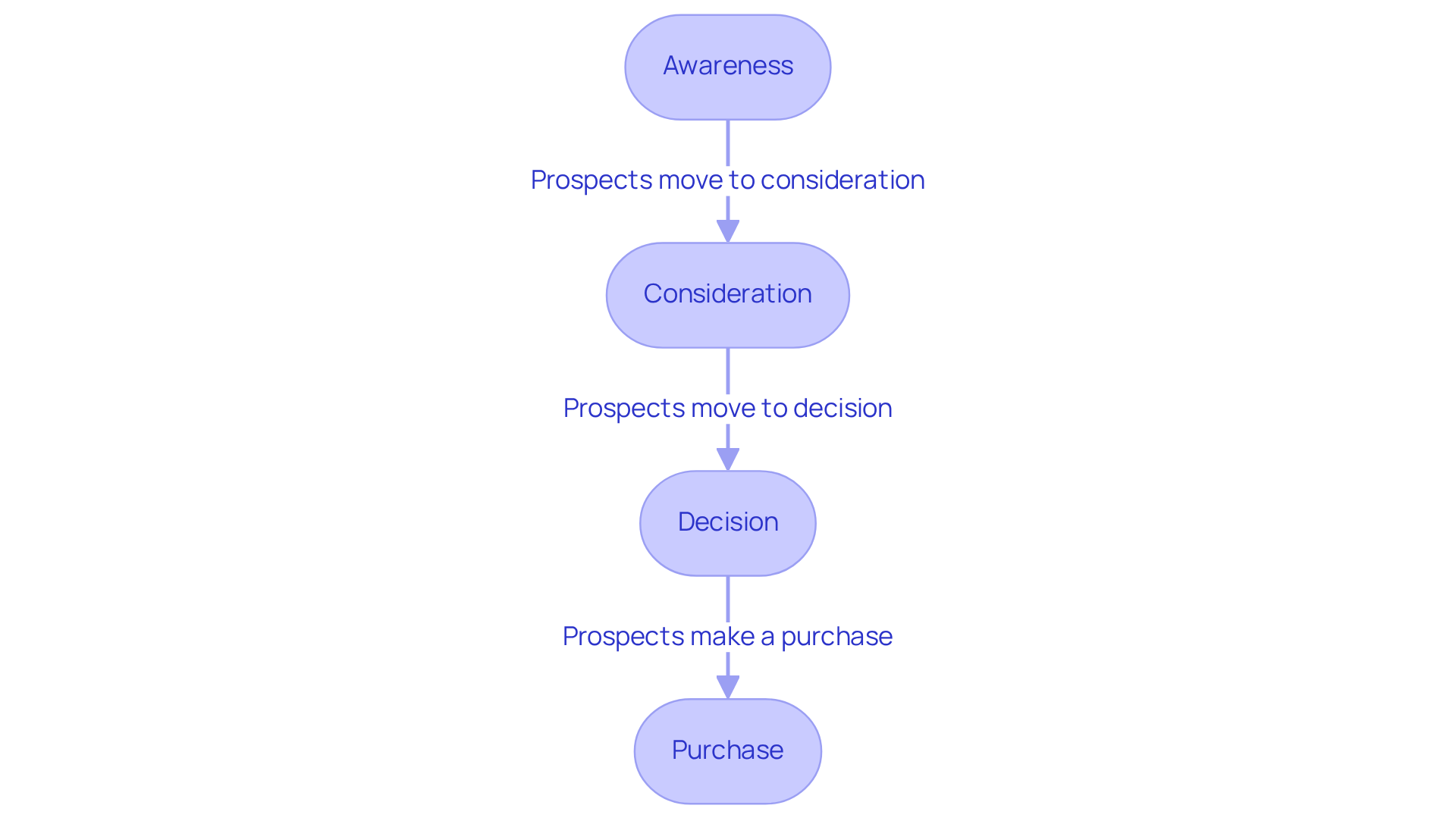
Contextualize the Marketing Funnel: Importance for Small Businesses
For small enterprises, the marketing funnel explained serves as a strategic guide for client acquisition, helping entrepreneurs visualize their sales processes and identify potential bottlenecks. This organized framework empowers small business owners to apply targeted strategies for cultivating leads, which is crucial since nearly 79% of leads do not convert without adequate nurturing. Moreover, nurturing leads can lead to larger purchases; in fact, 47% of nurtured leads buy more than their non-nurtured counterparts, underscoring the financial benefits of effective nurturing strategies.
By understanding the marketing funnel explained, small business owners can allocate their resources more efficiently, tailoring promotional messages to resonate with clients at various stages of their journey. This thoughtful approach not only maximizes the impact of every dollar spent but also boosts conversion rates. Brands that align their promotional efforts with consumer behavior see significantly better outcomes. For example, personalized calls to action convert 202% better than generic ones, illustrating the effectiveness of tailored messaging.
Additionally, companies that keep an eye on promotional trends achieve greater efficiency, improved ROI, and reduced client acquisition costs. Ultimately, leveraging the marketing funnel explained allows small enterprises to refine their tactics, ensuring that each phase of the customer experience receives the attention it deserves. It's also important to recognize the role of mobile optimization; with mobile accounting for 68% of all e-commerce traffic, focusing on digital strategies is essential for small businesses. Together, we can navigate these challenges and achieve success.
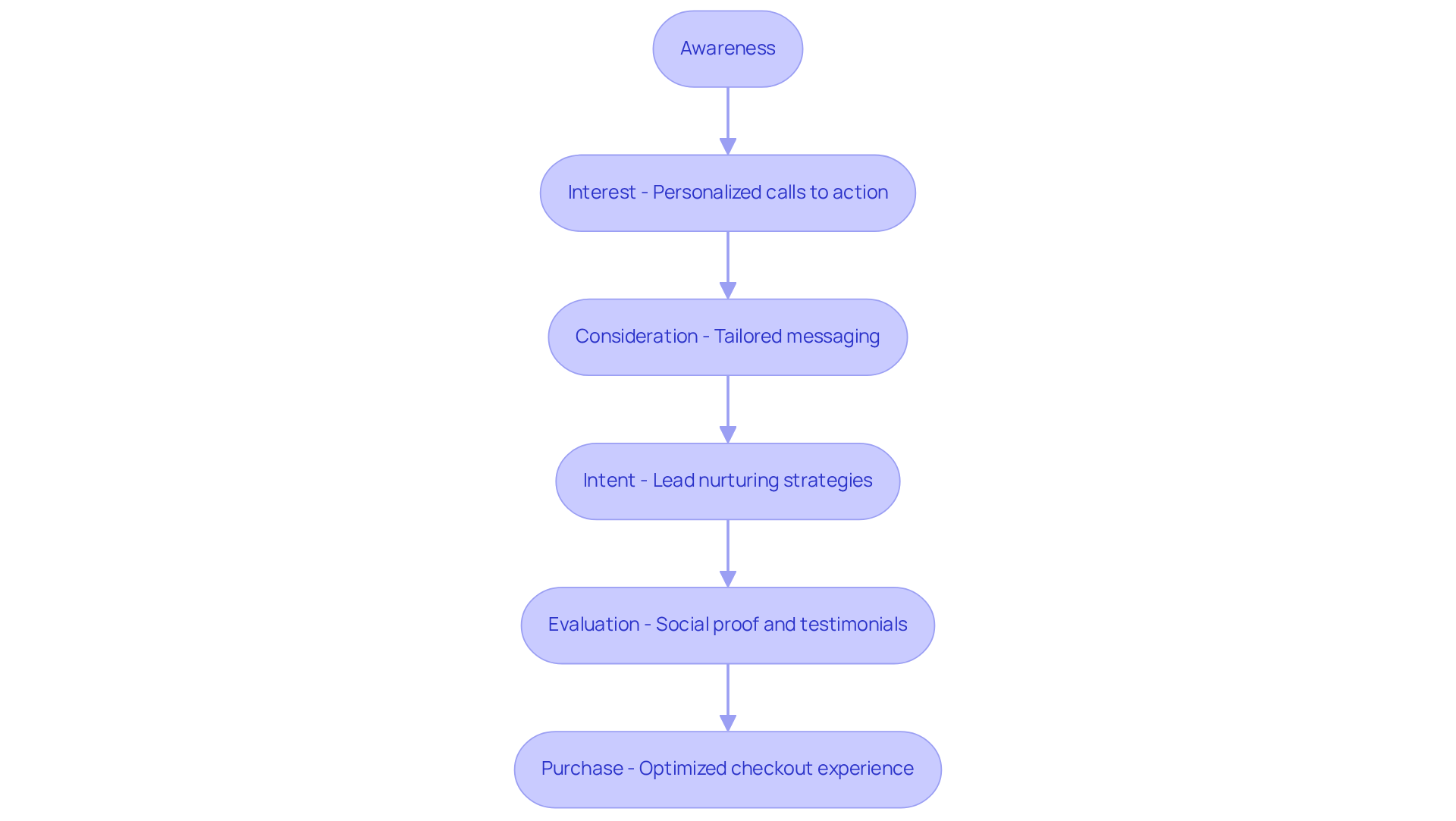
Trace the Origins of the Marketing Funnel: Historical Development
The concept of the promotional pipeline has its roots in the late 19th century, originating with the AIDA model—Awareness, Interest, Desire, Action—crafted by the advertising innovator Elias St. Elmo Lewis. This foundational model helps us understand consumer behavior and the stages involved in the marketing funnel explained during the buying process. Over the years, the evolution of the marketing funnel explained has embraced digital strategies, reflecting the shift in how consumers interact with brands from traditional methods to online platforms.
Today, the promotional pathway encompasses a variety of touchpoints, including:
- social media
- email outreach
- content creation
These elements are designed to adapt to the complexities of the modern consumer journey. As small business owners, we understand your challenges in navigating this landscape, and we are here to support you in effectively engaging your audience at every stage. Together, we can explore these strategies and empower your business to thrive in this dynamic environment.
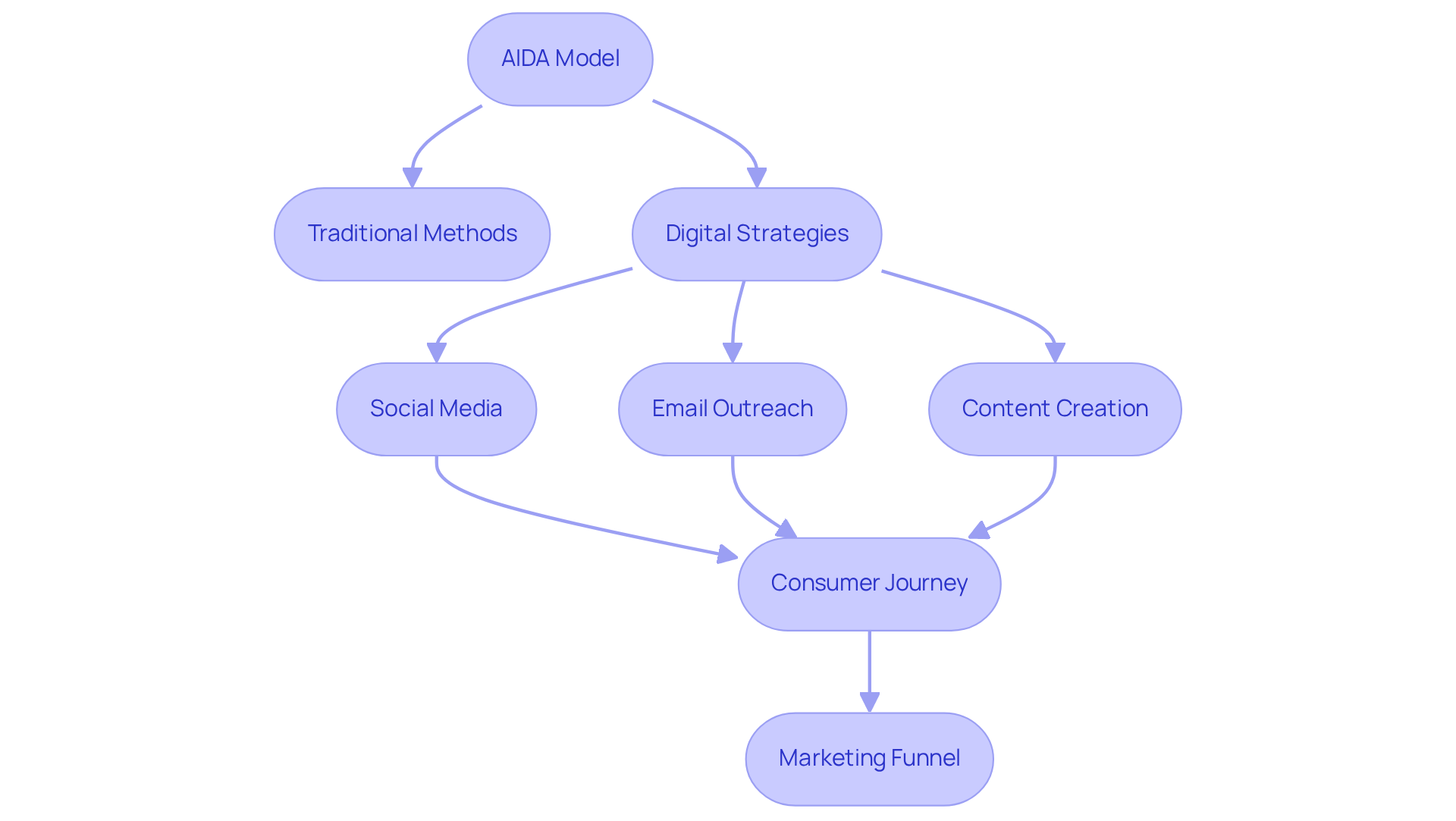
Examine the Key Stages of the Marketing Funnel: TOFU, MOFU, and BOFU
The marketing funnel explained consists of three essential stages: Top of the Funnel (TOFU), Middle of the Funnel (MOFU), and Bottom of the Funnel (BOFU). At TOFU, our primary focus is on creating awareness and attracting a wide audience through various methods such as content creation, social media, and advertising. This stage is all about capturing the attention of potential clients, with the ultimate goal of enhancing brand visibility. Have you considered how your current strategies can broaden your reach?
Moving to MOFU, we nurture leads who have shown interest in your offerings. This involves engaging them through targeted email campaigns and tailored content that addresses their specific needs. By doing so, we help build trust and guide them toward making informed decisions. Businesses that embrace effective MOFU strategies often witness a remarkable improvement in conversion rates, with nurtured leads generating 20% more sales opportunities compared to those that are not nurtured. Isn’t it encouraging to know that nurturing can lead to such positive outcomes?
Finally, we arrive at BOFU, where the conversion truly happens. Here, we employ strategies designed to close the sale, including personalized offers, compelling calls to action, and demonstrating value through testimonials or case studies. BOFU content should reassure potential clients about the necessity of your product, showcasing reviews and real-life success stories. By understanding these phases of the marketing funnel explained, small enterprises can craft tailored promotional strategies that effectively guide prospects along their journey, ultimately enhancing conversion rates. Remember, the typical conversion rate for sales channels across all sectors is 2.35%, providing a benchmark for small businesses to evaluate their performance. Together, we can navigate these stages and achieve success.
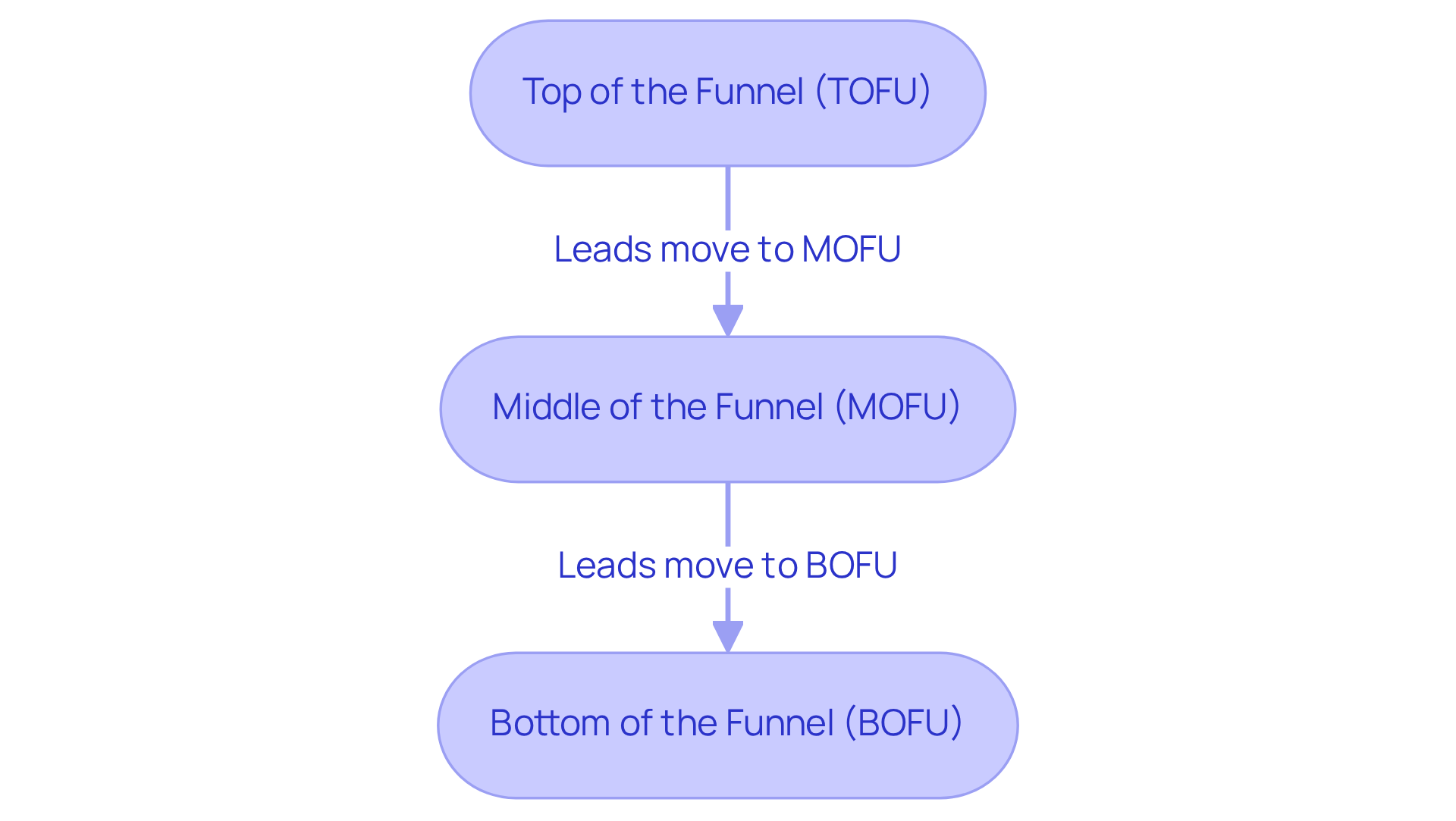
Apply the Marketing Funnel: Strategies for Effective Client Acquisition
To effectively utilize the sales funnel, small enterprises should start by clearly identifying their target demographic and creating detailed client profiles. As Peter Drucker wisely noted, "The goal of promotion is to know and comprehend the client so thoroughly that the product and services suit him and sell themselves." This foundational step opens the door to personalized promotional efforts that truly resonate with potential clients.
At the peak of the TOFU, businesses can embrace content strategies, such as engaging blog posts and active social media interactions, to draw in and capture the attention of potential customers. Recent statistics reveal that Twitter and Facebook are tied for second place among social media sites used by B2B content marketers, highlighting how essential these platforms are in reaching potential clients.
As they transition into the middle of the funnel (MOFU), nurturing leads becomes crucial. This can be accomplished through targeted email outreach campaigns that provide valuable resources and insights, fostering trust and keeping prospects engaged. A case study on B2B email strategies emphasizes that this approach is vital for cultivating meaningful relationships with clients.
Ultimately, at the base of the sales process (BOFU), small enterprises can encourage conversions by offering limited-time promotions or tailored consultations, creating a sense of urgency and relevance. By aligning promotional efforts with the distinct stages of the marketing funnel explained, small businesses can streamline their client acquisition processes and significantly enhance conversion rates.
As noted by industry experts, effective client acquisition hinges on understanding customer needs and crafting tailored experiences that guide them from awareness to advocacy. Joe Chernov emphasizes that top-of-the-funnel content must be "intellectually divorced from your product but emotionally wed to it," underscoring the importance of emotional connection in content marketing. This approach not only drives sales but also builds lasting relationships with clients.
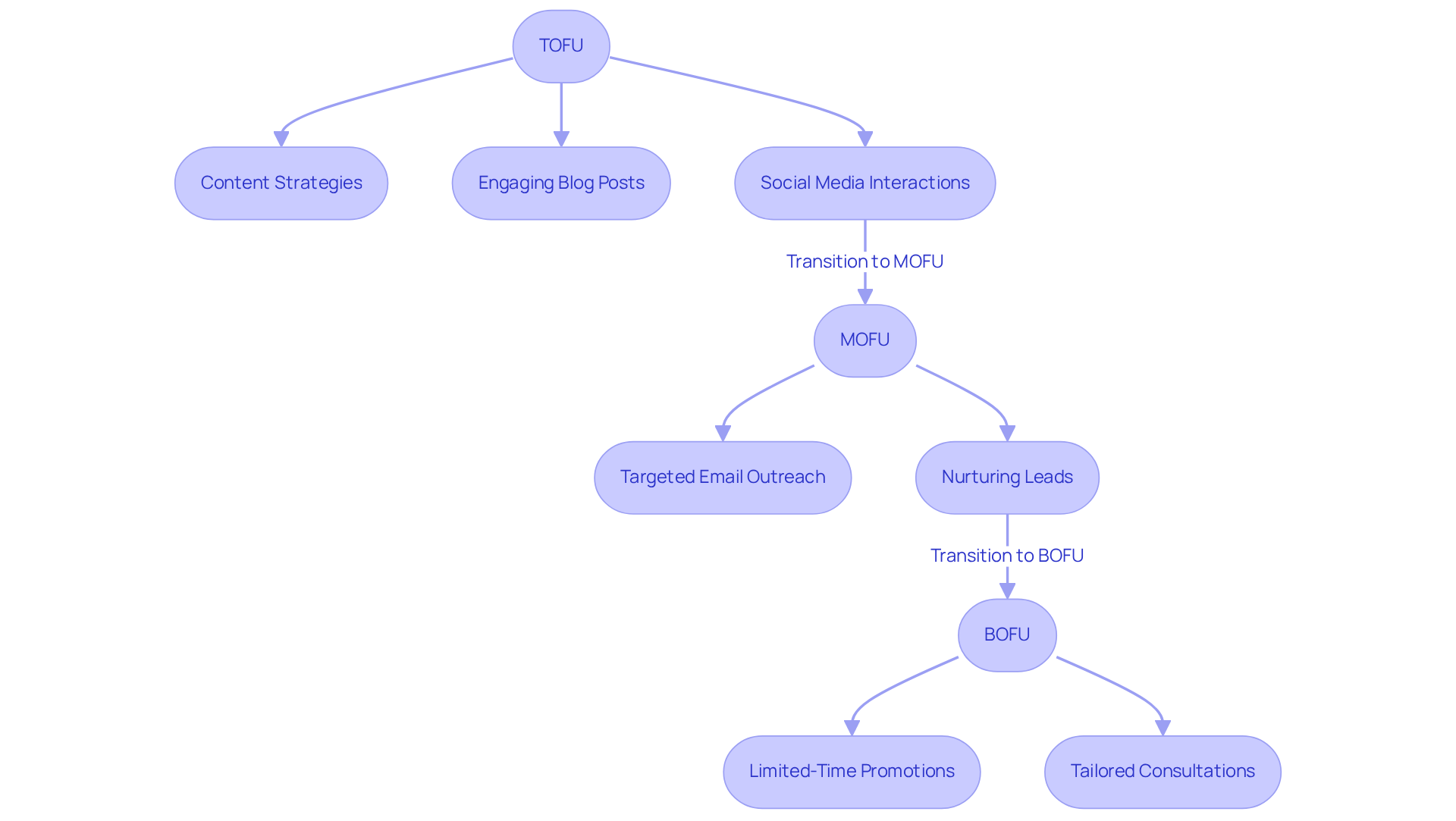
Conclusion
Navigating the complexities of customer acquisition and conversion can be daunting for small businesses, but the marketing funnel offers a guiding light. By embracing this essential framework, entrepreneurs can visualize the customer journey—from the moment potential clients become aware of their brand to the crucial decision to make a purchase. This strategic approach not only strengthens marketing efforts but also nurtures lasting relationships with clients, paving the way for increased sales and sustainable growth.
Each stage of the marketing funnel—TOFU, MOFU, and BOFU—holds significant importance. At the top, businesses attract a wide audience; in the middle, they nurture leads; and at the bottom, they close sales. Understanding the unique role each phase plays allows small businesses to guide prospects thoughtfully through their purchasing journey. Tailored messaging and effective lead nurturing are vital components that can optimize promotional strategies for better outcomes.
In today’s ever-evolving marketplace, leveraging the marketing funnel is not merely advantageous; it is essential for small businesses aiming for success. By adopting this model, entrepreneurs can allocate resources wisely, personalize their marketing efforts, and enhance customer retention. Together, we can navigate these challenges and build lasting connections with our audience, ensuring a brighter future for our brands. Remember, with the right strategies, small businesses can not only thrive but also create meaningful relationships that foster growth and community.
Frequently Asked Questions
What is the marketing funnel?
The marketing funnel is a promotional pathway that outlines the journey prospective clients take, from initial awareness of a product or service to the buying decision. It is visualized as a cone, with a wide top representing many opportunities and a narrow bottom indicating the fewer clients who make a purchase.
Why is the marketing funnel important for small businesses?
The marketing funnel helps small businesses understand and refine their promotional strategies by identifying where prospects are in their purchasing journey and how to effectively guide them toward conversion, ultimately enhancing customer engagement and driving sales.
What trends are expected regarding small businesses and promotional pathways by 2025?
By 2025, it is anticipated that around 70% of small enterprises will embrace promotional pathways, recognizing their importance in enhancing customer engagement and driving sales.
Can you provide examples of successful marketing strategies using the funnel?
Yes, for instance, Sensibo achieved a 111% year-over-year increase in new-to-brand sales in the U.S. by utilizing a comprehensive marketing strategy. Similarly, Pip & Nut reversed a 10% sales decline by adopting a thorough strategy, resulting in a 52% year-over-year rise in shipped units.
How does the marketing funnel assist in converting leads into clients?
The marketing funnel provides a systematic pathway that helps businesses engage with leads more effectively. Without it, businesses may struggle to convert leads into loyal clients, as customer journeys often do not follow a direct path from awareness to purchase.
What role does Wayy.ai play in the marketing funnel process?
Wayy.ai enhances the marketing funnel process by delivering daily email insights that monitor key metrics, such as the number of leads reached, interest expressed, and conversion rates. This empowers small business owners to make informed decisions and refine their strategies based on real-time data.
Why is nurturing leads important in the marketing funnel?
Nurturing leads is crucial because nearly 79% of leads do not convert without adequate nurturing. Additionally, nurtured leads tend to make larger purchases; 47% of nurtured leads buy more than their non-nurtured counterparts.
How can small businesses maximize the impact of their marketing spend using the funnel?
By understanding the marketing funnel, small business owners can allocate resources more efficiently and tailor promotional messages to resonate with clients at various stages of their journey, maximizing the impact of every dollar spent and boosting conversion rates.
What is the significance of mobile optimization in the marketing funnel?
Mobile optimization is significant because mobile accounts for 68% of all e-commerce traffic. Focusing on digital strategies is essential for small businesses to effectively engage with their audience and navigate challenges in the marketing funnel.




